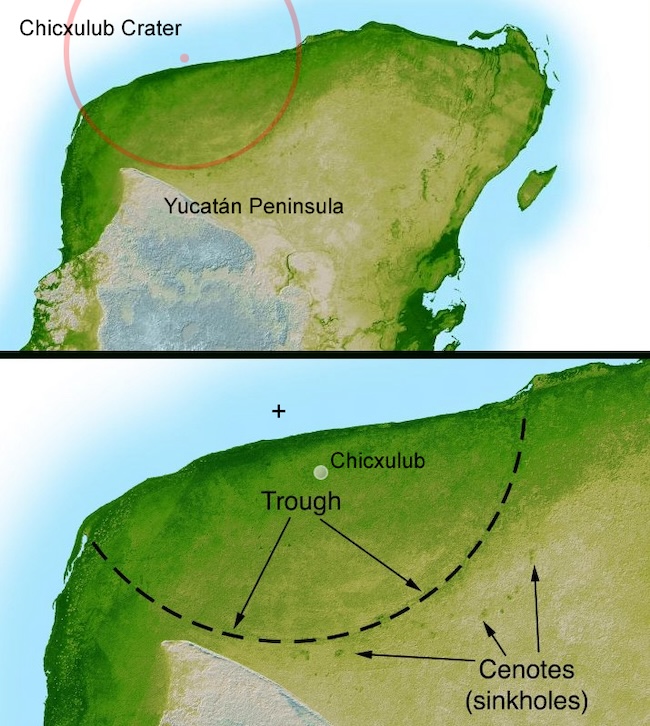- A massive asteroid impact killed off the dinosaurs about 66 million years ago. It happened in what is now the Gulf of Mexico and created a huge crater.
- Where did the asteroid come from? A new study says it originated in the outer solar system past Jupiter and contained a large amount of carbon.
- It wasn’t a comet that wiped out the dinosaurs, the study says, refuting previous theories.
Dinosaur-killing asteroid from beyond Jupiter
About 66 million years ago, an asteroid struck Earth and caused the extinction of the dinosaurs. It appears to have created the Chicxulub crater buried beneath the Yucatán Peninsula in Mexico. Since at least 1990, when scientists found the Chicxulub crater and identified it as an asteroid impact site, many have debated about what kind of asteroid it was. And now an international team of scientists says it has pinpointed the Chicxulub impactor’s origin and composition. The researchers reported on August 16, 2024, that it was a carbonaceous, or C-type, asteroid (containing rocks, metals and lots of carbon). They said the asteroid came this way from beyond Jupiter.
The research team, led by Mario Fischer-Gödde at the University of Cologne in Germany, published its peer-reviewed study in the journal Science on August 15, 2024.
Chicxulub, the dinosaur-killing asteroid
The Chicxulub asteroid is estimated to have been about 6 miles (10 km) in diameter. It struck Earth in what’s now the Gulf of Mexico, 66 million years ago. Scientists have said it was a key cause, if indeed not the cause, of the extinction of the dinosaurs. Scientists call the strike Cretaceous-Paleogene extinction event. As the paper said:
The geologic boundary between the Cretaceous and Paleogene eras 66 million years ago is marked by worldwide deposits from an impact at modern Chicxulub, Mexico. The impact coincides with a mass extinction that wiped out non-avian dinosaurs and many other species.
The impact supposedly created a huge crater, known today as the Chicxulub crater. It is about 120 miles (195 km) across and 12 miles (20 km) deep.
Why do scientists think an asteroid created this crater? For one thing, they found high levels of platinum-group elements (PGEs) such as iridium, ruthenium, osmium, rhodium, platinum and palladium in the K-Pg boundary layers. This is a geological signature, usually a thin band of rock containing much more iridium than other bands. These elements are rare on Earth, but they’re common in meteorites, or rocks from space. What’s more, similarly elevated PGE levels were also found globally. This finding suggests the impact spread debris around the world.
Previous to this finding, some scientists had interpreted these rare elements at the K-Pg boundary as evidence of volcanic activity. But many scientists believe the specific PGE ratios are more consistent with those from meteorite impacts.
Yet, even with this data, scientists still haven’t been sure exactly what kind of asteroid Chicxulub was, or where it came from.

A carbonaceous asteroid from beyond Jupiter
Most asteroids lie in the asteroid belt between Mars and Jupiter. Was the asteroid belt the origin of the asteroid that killed the dinosaurs? Fischer-Gödde said:
We wanted to identify the origin of this impactor.
Fischer-Gödde and his colleagues studied the evaluated ruthenium (Ru) isotopes in samples taken from the K-Pg boundary. Then, they compared those to samples from five other asteroid impacts within the last 541 million years, samples from ancient Archean (3.5 – 3.2 billion-years-old) impact-related spherule layers and samples from two carbonaceous meteorites.
The results showed that the ruthenium isotope signatures were uniform and closely matched those of carbonaceous chondrite meteorites, not other meteorite types or Earth itself. Also, the asteroid was most likely a C-type, or carbonaceous, the most common kind of asteroid. As the name suggests, they are rich in carbon. In addition, the asteroid also likely originated in the outer solar system, out past Jupiter.
Fischer-Gödde said:
The asteroid’s composition is consistent with that of carbonaceous asteroids that formed outside of Jupiter’s orbit during the formation of the solar system.
The ancient Archean samples supported these conclusions as well. The samples from the other five asteroid impacts, however, came from S-type (salicaceous) asteroids that originated from the inner solar system.
Not a comet
Also, the findings rule out the impactor being a comet instead of an asteroid, as some scientists had also postulated. As William Bottke, a planetary scientist at the Southwest Research Institute in Boulder, Colorado, noted:
The idea it was a comet goes back far into the literature. Sizeable carbonaceous asteroids are much more probable to hit the Earth than comets.
Fischer-Gödde also said the ruthenium-isotope data do not match a comet.
The Chicxulub impact was a rare event, but changed the course of evolution on Earth. Co-author Carsten Münker at the University of Cologne added:
We found that the impact of an asteroid like the one at Chicxulub is a very rare and unique event in geological time. The fate of the dinosaurs and many other species was sealed by this projectile from the outer reaches of the solar system.
Bottom line: An international team of scientists has determined that Chicxulub dinosaur-killing asteroid was carbonaceous and originated from the deep outer solar system.
Source: Ruthenium isotopes show the Chicxulub impactor was a carbonaceous-type asteroid
Via:
University of Cologne
Nature
American Association For the Advancement of Science (EurekAlert!)
Read more: Asteroid dust in Chicxulub crater seals deal on dino extinction
Read more: Ancient life signs under dinosaur-killing Chicxulub crater